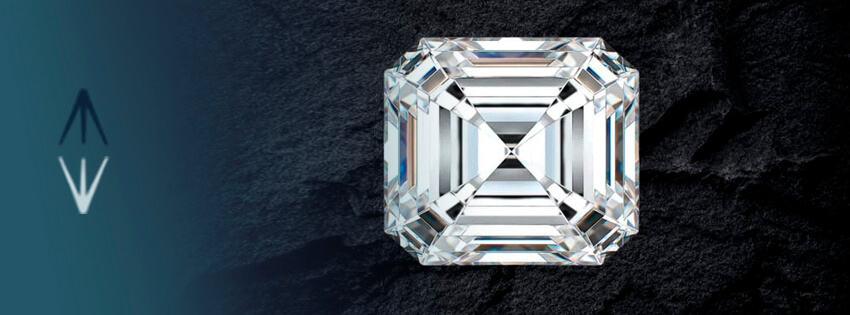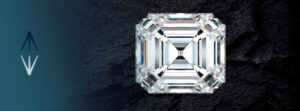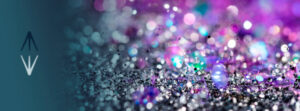In the world of high jewelry, some shapes never go out of style, while others make a strong comeback after years in the shadows. This is the case with the Asscher diamond, a cut with over a century of history that is now once again featured in the most coveted engagement rings and luxury jewelry.
At Diamantes, we help you discover what makes this unique cut so special and why more and more people are choosing it for their most meaningful moments.
What exactly is an Asscher diamond?
An Asscher diamond is a square-shaped gemstone with cropped corners and multiple facets that create a stunning geometric pattern. Its cut resembles a square version of the emerald cut, but with a unique depth and brilliance that sets it apart.
This cut belongs to the “step cut” category, known for its large, parallel facets that produce a more elegant and sophisticated brilliance than traditional brilliant cuts.
The Asscher Cut’s History: From 1902 to the Modern Revival
The Asscher cut was developed in 1902 by the Dutch company Royal Asscher Company. Its initial rise coincided with the Art Deco movement of the 1920s and 1930s, when geometric shapes and symmetry dominated design.
Although its popularity declined in the second half of the 20th century, it has made a strong comeback in recent decades due to its vintage aesthetic, timeless appeal, and ability to stand out in modern, custom designs.
Characteristics of the Asscher Cut
Cut is a key factor in a diamond’s beauty. Learn more about its importance in our 4Cs cut guide.
- Shape: Square with cropped corners.
- Facets: Traditionally 58, though the modern “Royal Asscher Cut” can have up to 74.
- Symmetry: Highly precise, ideal for those seeking perfection.
- Brilliance: Less sparkly than a brilliant cut but with a deep, elegant glow.
- Clarity: Requires high-quality stones, as its cut reveals internal inclusions.

Asscher vs Emerald: What’s the Difference?
Both cuts share the step-cut style, but the Asscher is squarer and more compact, while the emerald cut is rectangular. The Asscher creates a more dynamic, almost hypnotic optical effect thanks to its “hall of mirrors” and cross-shaped facet pattern.
Additionally, the Asscher typically has a higher crown and deeper pavilion, enhancing its three-dimensional appearance.
Advantages of Choosing an Asscher Diamond
- Vintage and timeless aesthetic
- Unique and eye-catching design
- High optical clarity
- Ideal for geometric and Art Deco settings
- Sophisticated yet understated appearance
An Asscher diamond blends classic and modern, subtle and striking — perfect for those with refined and original taste.
Why is it trending again?
The rise of custom designs and the search for unique pieces has brought the Asscher diamond back into the spotlight. Celebrities, designers, and modern couples are choosing it for its distinctive character and connection to vintage glamour.
Its perfectly symmetrical shape also aligns with today’s minimalist aesthetic, which values clean, structured, and elegant designs.
Is it suitable for engagement rings?
Absolutely. The Asscher diamond is perfect for engagement rings that aim to stand out with originality while maintaining elegance. It looks stunning in solitaires, halo settings, and geometric designs.
However, because it has less “scattered brilliance” than other cuts, it’s best to prioritize high-clarity and good color stones to maximize its beauty.
Conclusion
The Asscher diamond is a brilliant choice for those looking for a piece with history, style, and personality. Its return to the jewelry scene is no accident: it offers classic elegance, defined shapes, and a sophistication that never goes out of fashion.
If you’re looking for an engagement ring or a jewel with character, the Asscher diamond might be exactly what you’re looking for.
Frequently Asked Questions
What makes the Asscher diamond special compared to other cuts?
Its square shape, beveled corners, and step-cut facets create a deep, elegant sparkle — ideal for those seeking a sophisticated style.
How can you tell if an Asscher diamond is high quality?
Make sure it has high clarity and a symmetrical cut. This cut’s structure easily reveals internal inclusions or imperfections.
Can Asscher diamond rings be customized?
Yes, it’s a highly versatile cut for custom designs, especially in geometric settings, halos, or minimalist styles.
What types of jewelry feature Asscher diamonds?
Mainly engagement rings, but also earrings, pendants, and cocktail rings in vintage or Art Deco styles.




